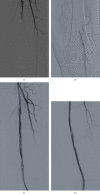Retrograde Popliteal Access for Challenging Superficial Femoral Artery Occlusion
- PMID: 34055413
- PMCID: PMC8149250
- DOI: 10.1155/2021/8833025
Retrograde Popliteal Access for Challenging Superficial Femoral Artery Occlusion
Abstract
Retrograde popliteal access has long been established as an alternative to the antegrade approach to occlusive lesions in the superficial femoral artery (SFA). However, early reports with high complication rates (dissection, hematomas, aneurysms, and arteriovenous shunts at the puncture site) reduced enthusiasm for this technique. In recent years, with the development of thinner sheaths and low profile angioplasty devices, retrograde popliteal access has resurfaced as a viable technique, mostly in combination with or after failure of the more classical antegrade approach. In this retrospective study, we will report the safety and efficacy of the retrograde popliteal approach in the treatment of superficial femoral artery chronic total occlusions, in 13 consecutive patients between January 2017 and January 2021. The results showed 100% successful puncture of the popliteal artery and 100% successful recanalization and stenting of the superficial femoral artery with a total of 2 complications related to the puncture site and zero periprocedural mortality. In conclusion, the retrograde popliteal approach appears to be an effective and safe alternative to the common SFA complete total occlusion (CTO) treatment approach.
Copyright © 2021 Georges Ibrahim et al.
Conflict of interest statement
The authors declare that there is no conflict of interest.
Figures
References
LinkOut - more resources
Full Text Sources
Other Literature Sources



